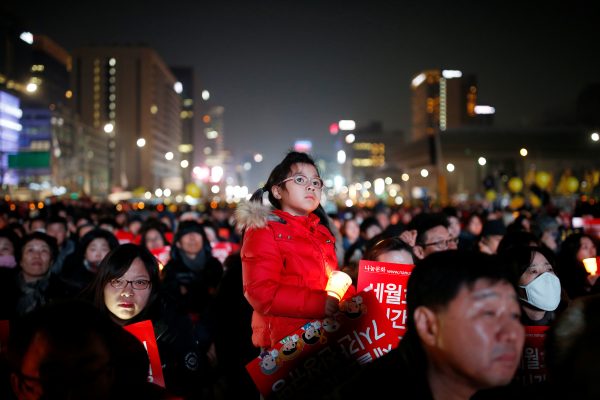In June 1987, another mass mobilisation eventually forced the authoritarian rulers to concede democratic reforms.
Political protest did not slow down with South Korea’s transition to democracy. On the contrary, street protest became the new normal as democratic space expanded. Students, workers, civic organisations, and even opposition political parties and lawmakers took to the streets in protest of government policies. Observing the pervasiveness of protest in South Korea in 2008, an Al Jazeera reporter came to the conclusion that ‘protest has become part of [South Korean] culture’. Given this context, the recent candlelight protests that erupted in response to the scandals of President Park Geun-hye and her confidante, Choi Soon-sil, were no isolated event.
The use of candlelight as a form of protest traces back to 2002 when two teenage girls were killed by US armoured vehicles on military training manoeuvres. A proposal for a candlelight vigil circulated among internet cafes after the news spread that the US soldiers responsible for the deaths of the Korean girls had been acquitted in the US court-martial. Thousands gathered in Gwanghwamun Square to commemorate the victims. The candlelight vigil was picked up by activist groups and turned into a symbol of the movement against the perceived injustice. Ever since 2002, mass demonstrations in South Korea have taken the form of candlelight protest.
The advent of the candlelight protest signified important changes distinct from earlier protests. In the past, it was impossible to picture a protest scene in South Korea without conjuring up the image of violent clashes and the exchange of teargas and Molotov cocktails between protesters and riot police. Violent protests persisted into the 1990s, well after South Korea’s democratic transition, but the emergence of the candlelight protest offered a new platform that enabled protesters to convey their seriousness of intent through peaceful means.
Specifically, the candlelight protests of the past three months have been remarkable in their absence of violence, despite the high political tension and massive number of protesters roaming the streets. On the one hand, this had to do with greater tolerance on the part of the police and favourable court rulings that opened up new marching routes previously unavailable to the protesters — a trend not uncommon during times of revolutionary change. But it also had much to do with the adept handling of the rallies and marches by the organisers.
The weekly candlelight protests were organised by Emergency Action for Park’s Resignation, a coalition of more than 1500 civic organisations. In the past, large coalitions were often plagued by fierce infighting among competing political groups. To avoid discord, the anti-Park coalition set rules for decision making based on the lowest common denominator among participant organisations.
Its role was focused on providing political space for citizens of all walks of life to come and express their views freely. From booking celebrities to setting up lost-and-found services, the coalition paid close attention to the details of the rallies to make them more accommodating to all.
Combined with unprecedented levels of frustration and anger among South Koreans, the outcome was explosive. Week after week, the coalition successfully mobilised millions of South Koreans on the streets of dozens of cities and channelled their anger into a powerful political message. Eventually, the candlelight protests pushed reluctant lawmakers to cast their vote to impeach the president in the National Assembly, marking one of the most significant events in South Korea’s political history.
The success of the anti-Park candlelight protests illuminates the growth and maturity of civil society in South Korea. At the same time, it brings to attention the weakness of its party system as a mechanism for political mediation. South Korean political parties have been characterised by their extreme fluidity, which involves frequent splits, mergers and name changes.
In the absence of stable political parties with which to communicate political agendas and develop a shared identity, civil society organisations often bypassed the mediation of political parties when it came to promoting new agendas or resisting policies. Consequently, direct action was frequently used as leverage vis-à-vis the decision makers.
The latest candlelight protest set an unusual example in that street protesters and opposition lawmakers found themselves in sync throughout the impeachment campaign as well as the subsequent legal proceedings. But this rare accord is unlikely to be sustained as the ruling party goes through another split and the fractured opposition field prepares for an early presidential election in late spring, pending confirmation of President Park’s impeachment by the Constitutional Court.
Lacking a reliable partner in party politics, the anti-Park coalition will likely break into multiple political lines as the competition for the president’s office deepens. Precisely because they lack reliable partners in party politics, however, they will most likely get together again and return to street politics when there is another serious breach of democratic principle. Protest politics will continue in South Korea.
Sun-Chul Kim is Assistant Professor of Korean Studies at the Department of East Asian Languages and Cultures, Emory University.


Thanks for an informative summary of the history of protest in South Korea. It takes much effort and time to get politicians to take action on an issue most of the time largely because they are, by nature, cautious about making changes. But it is still heartwarming to see that these marches have been effective.
Is the fluidity of political parties in the ROK a way these politicians have found to respond to a particular issue(s) without having to really make more substantial, systemic changes in the way the government operates? Eg, the parties may change their names, reorganize their membership, and then present different agendas. But meanwhile the underlying system where the chaebol are extremely powerful remains unchanged?